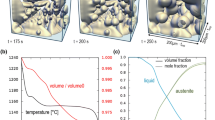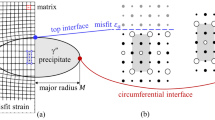Abstract
General expressions are derived for the calculation of the total product phase grain edge length per unit volume L βββV and the total number of product phase quadruple points per unit volume QV (i.e., ββββ quadruple points) at any given time during solid state transformations occurring by nucleation and growth process. It is shown that, {
} and, {
} where VVex is the extended volume fraction of the product phase, and SVex is the total extended product phase-matrix interfacial area per unit volume. It is assumed that the spatial distribution of the product phase nuclei is random. The analysis is applicable to any arbitrary time dependent nucleation rate, and any arbitrary time and/or size dependent growth rate, provided that the product phase particles have an equiaxed shape in the extended structure. The analysis is applicable to isothermal transformations as well as nonisothermal and continuous cooling transformations. It is shown that L βββV and QV are basically determined by the path of microstructural evolution described by the variation of product phase-matrix interfacial area per unit volume with the volume fraction of the product phase. The ASTM grain size number of the transformed microstructure and average grain shape can be calculated from these results.
Similar content being viewed by others
References
A. M. Gokhale: Metall. Trans. A, 1988, vol. 19A, pp. 2123–31.
W. A. Johnson and R. F. Mehl: Trans. AIME, 1939, vol. 135, pp. 416–58.
R. E. Miles: Proc. of 4th Int. Conf. for Stereology, E. E. Underwood, ed., NBS special publication 431, Washington, DC, 1976, pp. 3–12.
A. M. Gokhale: Metall. Trans. A, 1984, vol. 15A, pp. 243–45.
L. A. Santalo: Integral Geometry and Geometric Probability, vol. 1, Encyclopedia of Mathematics and its Applications, Gian Carlo Rota, ed., Addison-Wesley Publishing Co., 1976, pp. 109–27.
J. L. Meijering: Philips Res. Rep., 1953, vol. 8, pp. 270–90.
A. M. Gokhale: Trans. Indian Inst. Metals, 1982, vol. 35, pp. 595–600.
A. M. Gokhale and R. T. DeHoff: Metall. Trans. A, 1985, vol. 16A, pp. 559–64.
C. S. Smith and L. Guttman: Trans. AIME, 1953, vol. 197, pp. 11–27.
Author information
Authors and Affiliations
Rights and permissions
About this article
Cite this article
Gokhale, A.M. Calculation of the product phase grain edge length and quadruple points per unit volume during solid state transformations. Metall Trans A 20, 349–355 (1989). https://doi.org/10.1007/BF02653913
Received:
Issue Date:
DOI: https://doi.org/10.1007/BF02653913




